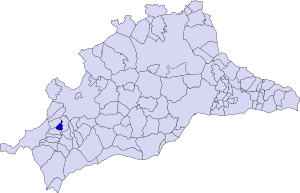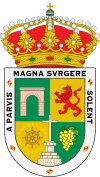Atajate facts for kids
Quick facts for kids
Atajate
|
||
|---|---|---|
 |
||
|
||

Municipal location in the Province of Málaga
|
||
| Sovereign state | ||
| Autonomous community | ||
| Province | ||
| Comarca | Serranía de Ronda | |
| Area | ||
| • Total | 11 km2 (4 sq mi) | |
| Elevation | 750 m (2,460 ft) | |
| Population
(2018)
|
||
| • Total | 169 | |
| • Density | 15.4/km2 (39.8/sq mi) | |
| Demonym(s) | Atajateños | |
| Time zone | UTC+1 (CET) | |
| • Summer (DST) | UTC+2 (CEST) | |
| Postal code |
29494
|
|
| Website | www.atajate.net | |
Atajate is a small town in southern Spain. It is located in the Málaga province, which is part of the Andalusia region. Atajate is nestled in the beautiful Genal Valley. It is also part of the Serranía de Ronda area. This town is known for being the least populated place in the Málaga province.
Contents
A Look at Atajate's Past
Atajate has a very long history. People lived here even in ancient times.
Early Settlements
Archaeologists have found old tools in the area. These include polished stones and axes from the Stone Age. Bronze items from the Copper Age have also been discovered.
Roman and Visigoth Times
The Romans built roads near Atajate. You can still find parts of an old Roman road. Roman coins have also been found. Later, the Visigoths lived here. Evidence of their burials has been found in a place called Montecillo.
Muslim Influence
During the time of Muslim rule, there were settlements in places like Port of Jimera and El Llano. There was also an old village called Audalázar nearby.
Becoming Part of Spain
In 1496, Atajate became part of the Lordship of Ronda. This meant it was controlled by Prince Don Juan. A few years later, in 1499, it became part of the Crown of Castile and Aragon. This made it officially part of Spain.
Churches and Roads
The first church in Atajate was created in 1505. Later, the Church of San Jose was built around the 1800s. Sadly, French soldiers damaged the old church in 1810. It was never rebuilt. In the 1930s and 1940s, important roads were built. These roads connected Atajate to other towns like Ronda and Gaucín.
Places to See
Atajate has some interesting old buildings and sites.
- Former San Roque Parish Church
- St. Joseph's Church
- Arab Tower
Fun Festivals
Atajate loves to celebrate! Here are some of its main festivals:
- Fiesta del Mosto: This is a celebration of "must" wine. Must is grape juice before it turns into wine. It happens on the last Saturday of November.
- Motorcycle Rally: A fun event for motorcycle fans. It takes place the week before the Fiesta del Mosto.
- Pilgrimage Atajate - Alpandeire: People walk from Atajate to Alpandeire. They do this to honor San Roque de Montpellier, a shared patron saint. It's on the last Saturday of summer.
- Guerra del Agua: This means "Water Fight"! It's a famous and fun water fight in the area. It happens on the Saturday of the Fiesta de San Roque.
- Fiesta de San Roque: This is a big festival on August 15, 16, and 17.
- Corpus Christi procession: A religious procession that usually happens in May or June.
- Fiesta del Huerto: This festival takes place on Easter Sunday.
- Carnival: A lively celebration before the start of Lent. The date changes each year.
Local Food
The food in Atajate uses fresh ingredients from the land. What you eat depends on the season.
Year-Round Dishes
You can always find hearty "mountain pots" here. These are stews often made with chickpeas or lentils. There are also many tasty pork dishes and sausages. Rabbit stew is another popular meat dish.
Springtime Flavors
In spring, people cook with wild herbs. You might find dishes with thistles, fennel, or wild asparagus.
See also
 In Spanish: Atajate para niños
In Spanish: Atajate para niños



